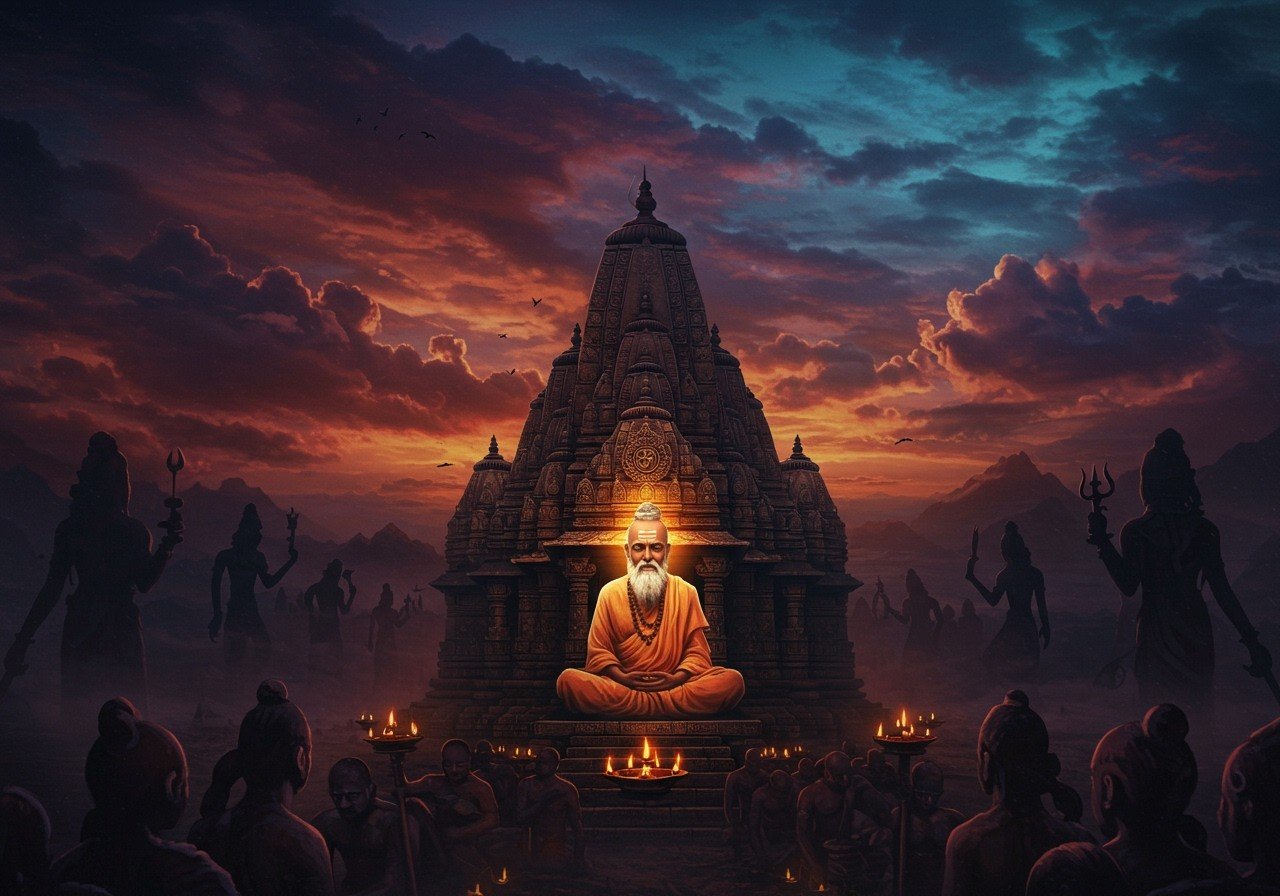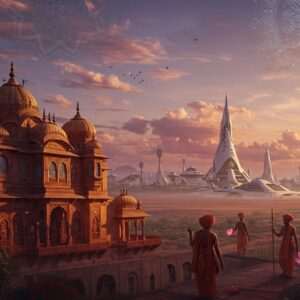
The concept of Kali Yuga, often called the ‘Age of Strife’ or ‘Age of Darkness,’ holds deep significance in Hindu cosmology. It’s the final stage in the cycle of four Yugas, a vast period of time depicting the cyclical nature of existence. This era is believed to be characterized by a decline in morality, ethics, and spiritual values, a stark contrast to the preceding ages of truth and virtue. Exploring the beginning, end, and the role of Kali within this Yuga unveils profound insights into Hindu philosophy and its perspective on time and human existence. It offers a framework for understanding the challenges we face today while guiding us towards spiritual growth and resilience.
The Dawn of Kali Yuga
According to the Puranas, ancient Hindu scriptures, Kali Yuga commenced on February 18th, 3102 BCE. This date is associated with a unique planetary alignment, a celestial marker of this pivotal shift. The start of Kali Yuga also coincides with the departure of Lord Krishna, a divine presence whose absence signifies the waning of dharma, or righteousness. This transition ushers in an age characterized by moral and spiritual decline, as foretold in these sacred texts. It’s important to note that some interpretations of the scriptures use different calendars, and so the exact date can vary. However, the symbolism remains powerful – a transition from an age of divine presence to an age of increased human challenges.
When will Kali Yuga End?
Kali Yuga spans an immense 432,000 years. As of 2025 CE, we are approximately 5,126 years into this era, which means a substantial 426,874 years remain before its conclusion. The end of Kali Yuga will usher in a new cycle of Yugas, beginning with Satya Yuga, the Age of Truth. This vast timeline offers a profound perspective on human existence within the grand scheme of time. While the challenges of Kali Yuga may seem daunting, the cyclical nature provides hope for renewal and the eventual return of dharma. It encourages us to cultivate enduring strength, resilience, and devotion to spiritual practices that will help us navigate these complex times.
Who is Kali?
It’s crucial to distinguish Kali, the symbolic personification of strife in Kali Yuga, from Goddess Kali, the revered divine mother. Kali in Kali Yuga is not a deity but a demonic figure representing negative forces like conflict, moral decay, and suffering. His influence is believed to contribute to societal challenges, including falsehood and adversity. Understanding this distinction helps clarify the nature of this era. It’s not about worshipping a negative force, but rather understanding the spiritual challenges symbolized by Kali. This knowledge empowers us to recognize and resist these negative influences while striving to uphold dharma.
The Cultural Impact of Kali Yuga
Kali Yuga has profoundly impacted Indian culture and spirituality. It provides a framework for understanding the current state of society, serving as a symbolic lens through which we can interpret contemporary challenges and moral dilemmas. This understanding underscores the significance of adhering to dharma, even amidst adversity. Traditional practices, festivals, and rituals often reflect the influence of Kali Yuga, emphasizing the importance of upholding righteousness and maintaining a connection with the divine. These practices are not merely ancient traditions but also relevant tools for navigating the challenges of modern life, promoting introspection, spiritual growth, and resilience.
Navigating Contemporary Society through the Lens of Kali Yuga
The principles of Kali Yuga hold remarkable relevance in today’s world. They provide a spiritual context for understanding contemporary issues like corruption, inequality, and social unrest. These principles inspire us to live ethically, cultivate spiritual awareness, and seek deeper meaning in our lives. They provide a framework for addressing modern complexities by returning to simpler, virtuous ways of living. By understanding and applying these principles, we can develop the inner strength and resilience needed to navigate the challenges of our times, ultimately fostering a more harmonious and virtuous existence.
How Poojn.in Can Support Your Spiritual Journey in Kali Yuga
At poojn.in (https://www.poojn.in), we offer a wide selection of authentic spiritual products to support your journey through Kali Yuga. We understand the importance of upholding dharma and connecting with the divine, especially during challenging times. Our collection includes items for personal devotion, ritual practices, and creating a sacred space in your home.
Explore our diverse range of products:
- Pooja Samagri: Discover a wide variety of essential items for your daily puja rituals, from diyas and incense to puja thalis and more. This comprehensive collection is designed to help you create a sacred and serene atmosphere for your worship.
- Culturally Significant Items: Immerse yourself in the rich traditions of India with our curated collection of culturally significant items. These items are perfect for deepening your understanding of Hindu culture and incorporating its values into your daily life.
- Holy Books: Delve into the wisdom of the scriptures with our collection of holy books, including the Bhagavad Gita and other sacred texts. These books offer profound insights and guidance for navigating the complexities of life and deepening your spiritual understanding.
- Dashakarma Items: For rituals and ceremonies related to Lord Vishnu’s avatars, including Kalki. These items are crafted with care to ensure they meet traditional standards.
Experience convenient online shopping with poojn.in. We offer delivery across India, bringing the sanctity of tradition to your doorstep.
Contact Us: Call us at 03369029784 or WhatsApp us at 9476142738.
Embracing the Path through Kali Yuga
While Kali Yuga presents its share of challenges, it also offers profound opportunities for growth. It compels us to hold steadfast to dharma, even when surrounded by adversity. The essence of Kali Yuga teaches us to seek truth, embrace spiritual practices, and cultivate inner resilience. By understanding the cyclical nature of time in Hindu philosophy, we gain valuable insights for navigating life’s complexities with greater wisdom and purpose. This journey is not just about enduring the darkness, but about fostering inner strength, cultivating compassion, and nurturing the hope for renewal.
Understanding Kali Yuga: Frequently Asked Questions
What defines Kali Yuga? Kali Yuga, often referred to as the “Age of Darkness,” represents the fourth and final stage within the cycle of Yugas, marked by a decline in dharma and spiritual values. It presents unique challenges and opportunities for spiritual growth. It’s a time when adherence to truth and inner strength are tested, but also where true spiritual progress can be made.
When did Kali Yuga begin? As per traditional Hindu texts, Kali Yuga commenced around 3102 BCE, coinciding with Lord Krishna’s departure from the earthly realm. This period signifies a shift towards a more challenging era for humanity, calling for increased inner strength. It’s important to understand this isn’t a fixed date, but a symbolic marker of transition.
When will Kali Yuga conclude? Kali Yuga is believed to span 432,000 years. Currently, we are a relatively short time into this cycle, with thousands of years still to unfold. The end of Kali Yuga will herald the dawn of Satya Yuga, restarting the cycle with renewed purity. This cyclical understanding of time provides context and perspective on our current moment.
Who is Kali in the context of Kali Yuga? In Kali Yuga, Kali represents a demonic figure symbolizing negativity and strife, distinct from the revered Goddess Kali. This figure embodies the challenges and moral complexities of the age. He’s a symbolic representation of the forces that oppose dharma and create obstacles on the spiritual path.
What characterizes life during Kali Yuga? Kali Yuga is often associated with a decline in moral values, increased materialism, and societal discord. It is a time that tests individuals’ commitment to dharma, and encourages deeper self-reflection. This era calls upon us to maintain spiritual integrity amidst the prevalent challenges. It’s a period where finding inner peace and clinging to truth becomes crucial.
How can one live righteously amidst the challenges of Kali Yuga? Upholding dharma, practicing kindness, truthfulness, and maintaining devotion are essential for navigating Kali Yuga. It’s also a time for seeking guidance through scripture, and strengthening one’s spiritual practice. This period emphasizes the importance of self-awareness, self-control, and remaining connected to one’s inner compass.
What significance does the end of Kali Yuga hold? The end of Kali Yuga marks the beginning of Satya Yuga, the age of truth and purity, thereby initiating a new cycle. It’s a time of renewal and restoration of balance within the universe. It signifies the cyclical nature of time and existence, suggesting a continuous process of decline and renewal.
Why is Kali Yuga considered important? Kali Yuga serves as a period of spiritual testing and growth. It prompts self-reflection, fosters resilience, and emphasizes the enduring importance of dharma. Understanding this age provides profound insights into human nature and the cyclical nature of existence. It’s an opportunity to learn valuable lessons, cultivate essential qualities, and prepare for the eventual return of Satya Yuga. It highlights the importance of personal spiritual practice, and the continuous effort required to uphold truth and righteousness, even amidst challenging circumstances.

